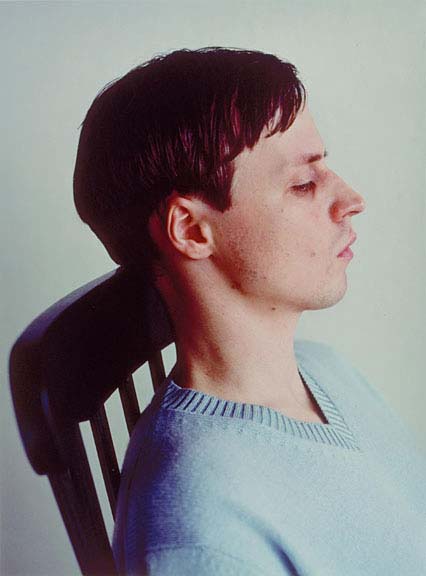Sharon Lockhart
dal 5/10/2000 al 4/11/2000
Segnalato da
5/10/2000
Sharon Lockhart
Barbara Gladstone Gallery, New York
The exhibition include a new photograph portraying a man and woman in a wooded landscape. The primary focus of the show are the photographic series from Lockhart's most recent projects in Brazil and Mexico. The Brazil photographs were inspired by the communities that once supported a flourishing rubber-production industry which in its heyday afforded Manaus, Amazonas' opulent late 19th century opera house: the Teatro Amazonas.

The exhibition include a new photograph portraying a man and woman in a wooded landscape. The primary focus of the show are the photographic series from Lockhart's most recent projects in Brazil and Mexico. The Brazil photographs were inspired by the communities that once supported a flourishing rubber-production industry which in its heyday afforded Manaus, Amazonas' opulent late 19th century opera house: the Teatro Amazonas.
Lockhart's film of the same name offers a portrait of the city via an audience of its inhabitants (Teatro Amazonas will be screened in the New York Film Festival on October 8). Lockhart's second project focuses on the repair of the stone floors of the National Museum of Anthropology in Mexico City. Both projects examine the cultural gaze as it is framed by anthropology and ethnography.
For the Brazil project, the artist worked with two anthropologists along the Aripuaña River Region and on the island of Apeú-Salvador in Pará. The works relating to the Aripuaña River Region consist of Interview Locations and Family Photographs. Lockhart and anthropologist Ligia Simonian traveled the region by boat for 17 days interviewing the inhabitants of the small villages that once supported Brazil's booming rubber industry.
Simonian initially sought to study the roles of women in the rubber-tapping industry, but came to survey the region and track the population as it had been flowing away from the area. She interviewed families in their homes, and afterwards Lockhart photographed the sites devoid of their human subjects. Lockhart groups the Interview Locations with rephotographed snapshots from the families' personal collections, evoking untold narratives that the viewer can never access. As Timothy Martin has noted, "an incredible tension surrounds the 'absent' human subject, for the work locates itself in between an intensely detailed perspective of the family's material surroundings and habiliments and an almost excruciating glimpse into its sentimental interior."
The island series take a different approach. Here, Lockhart photographed the inhabitants of Apeú-Salvador, where anthropologist Isabel Soares de Souza surveyed kinship relations. For Families, Lockhart met with a family in their home to discuss her project, and asked where they would like to be photographed. She then took one photograph and a Polaroid, allowing the subjects to see and rearrange themselves if they liked, repeating the process for two more portraits.
In this collaboration, Lockhart's black-and-white triptychs become hybrid self-portraits. The second series from Apeú-Salvador, Maria de Conceição Pereira de Souza with the Fruits of the Island, portrays the stereotypical voluptuous woman bearing fruit, yet Lockhart's sensitivity is distinctly female, "for in these images the gaze of objectivity and affection are co-present with such clarity and balance that they reach a kind of stalemate, a terminus of incommensurability" (Martin).
Lockhart's series from the National Museum of Anthropology in Mexico City also probes the ethnographic gaze. Here the institution is the conceptual frame for the work, but it does not determine the images. Lockhart documents the perpetual project of repairing the museum's stone floors. In Enrique Nava Enedina: Oaxacan Exhibit Hall we see the primary laborer at work behind a glass partition separating him from the public, while the glass cabinets protecting the museum's artifacts from the public are in the background: exactly what is on exhibit here? The beauty of Lockhart's work lies in the way she subtly lures us into another world, only to make us keenly aware that it is not ours to behold.
The artist is the recipient of the Rockefeller Foundation Film/Video/Multimedia Fellowship; the DAAD Artist in Residence Fellowship, Berlin; the City of Los Angeles Cultural Affairs Department Individual Artist Grant; the Asian Cultural Council Grant for the Artist in Residence Fellowship, Ibaragi, Japan; The Kunstlerhaus Bethanien Artist in Residence Fellowship, Stüttgart; and the Art Matters Grant, New York. One-person exhibitions include Museum Boijmans Van Beuningen Rotterdam (traveled to Kunsthalle Zürich and Kunstmuseum Wolfsburg); Pitti Imagine Discovery, Florence; The Kemper Museum of Contemporary Art and Design, Kansas City, MO; Pacific Film Archive, Berkeley Art Museum, Berkeley, CA; and Kunstlerhaus Stüttgart. Forthcoming is the Museum of Contemporary Art, Chicago (travels to the Museum of Contemporary Art, San Diego). Sharon Lockhart lives and works in Los Angeles.
Teatro Amazonas will be screened on Sunday, October 8th at 7pm at Lincoln Center's Walter Reade Theater as part of the New York Film Festival's "Views from the Avante Garde."
Gladstone Barbara - 515 West 24th St. - 10011 New York - Tel. 206.9300 - Fax. 206.9301



